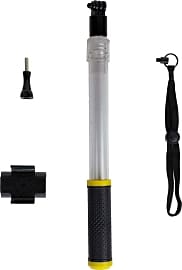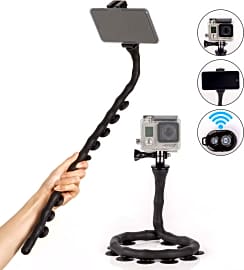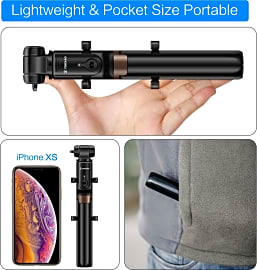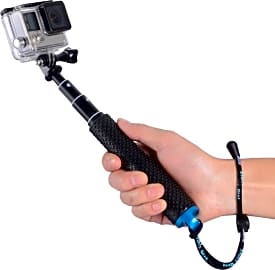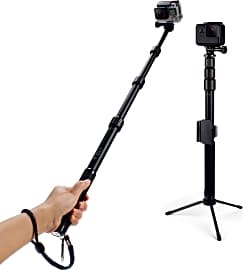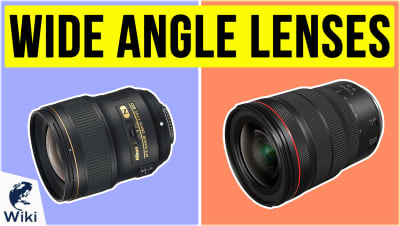The 8 Best Waterproof Selfie Sticks

This wiki has been updated 33 times since it was first published in March of 2017. Whether you're an aquatic adventurer who enjoys scuba diving, surfing or sailing, or you just like taking photos in your own backyard pool, one of these waterproof selfie sticks will definitely come in handy. Made from sturdy and lightweight materials and with a range of extendable lengths, they protect your camera or phone while allowing you to snap shots from unusual angles. When users buy our independently chosen editorial recommendations, we may earn commissions to help fund the Wiki.
Editor's Notes
September 07, 2019:
Taking a great selfie is harder than it looks, especially if you're trying to capture a unique shot or video with an action camera. You need to get the lighting, angle, and distance just right--and that's tricky to do if you're using just your arms. That's why a selfie stick is a worthwhile purchase. They give you much greater range in terms of distance and angle so you can add some personality and variety to your photos and videos.
Our selection of waterproof options will help you capture the moments, even if those moments are soaking wet. In this update, we evaluated items based on quality, ease of use, feature-richness, and value, and removed some items due to concern about their availability. We added the Shihong Bendable, which we like for its versatility. You can use it as a selfie stick, of course, but also as a monopod that you can mount anywhere, giving you much more choice than the standard telescoping option that does not bend. And it comes with a Bluetooth remote shutter so you don't have to mess with the timer on your camera or phone.
Tips For Taking The Perfect Selfie
We should mention, of course, that the best way to take a great picture is by taking lots of pictures — so don't just snap one and expect it to be a winner.
Millions of years for now, when an advanced alien race sifts through the wreckage of our civilization, your selfies might be the only clue they have as to how we lived.
So, try to take a good one, will you?
Of course, that's easier said than done. If your selfies tend to end up looking more alarming than charming, here are a few tips to help you make your next photo a masterpiece.
The main thing to keep in mind is that a selfie is just a picture, and so the basic rules for photography still hold true. That means you should focus on three main things: lighting, framing, and the camera itself.
Your camera is the most important consideration. If you have an old, outdated phone, you're simply not going to be able to match what a top-of-the-line smartphone can offer, especially if you tweak it to boost its abilities.
Still, even if your phone is a glorified brick, you can take some good pictures with it — provided you know what you're doing. Any shutterbug who can get the most out of the available lighting can finesse a quality photo from even the clunkiest of cameras.
Natural light is best, as fluorescent lighting can wash you out and leave you looking pale and haggard. Try to avoid shadows, unless you're going for a pic that's more artistic than glamorous. Use the flash sparingly, and preferably not at all, but you'll likely have no choice if you just have to snap that photo of you looking drunk at the bar.
If you're really serious, of course, you can try to bounce light onto your face from favorable angles. This can be achieved with something as simple as a white piece of paper or a little tin foil — but if someone catches you, you can expect your vanity to be the butt of a few jokes.
Composition is the other technique that sets professional-looking photos apart from amateur snaps. Don't just start clicking away without thinking about it — take the time to frame your shot properly. Remember the rule of thirds, which states that you should divide the photo into three sections both horizontally and vertically (giving you a grid with nine boxes, essentially).
Then, try to align yourself with one of the vertical lines of the grid. Leave room in the frame for the rest of the background, which is hopefully something interesting. Try to align the landscape in the background with the horizontal lines of the grid — preferably the bottom one, so that it's not bisecting the middle of the frame.
We should mention, of course, that the best way to take a great picture is by taking lots of pictures — so don't just snap one and expect it to be a winner. Fire away until you get one that's worth posting.
If you follow all these suggestions, you'll start taking selfies that are gorgeous, interesting, and most importantly, eminently "like-able."
Okay, But How Do You Take Selfies Underwater?
Anyone can look great standing in front of the Grand Canyon, but how do you look your best when you're soaking wet?
The good news is, chances are people won't necessarily be looking at you when you take a picture in the water. They'll either be looking at the sea life, the beach, or, well, your bikini.
If you have long hair, try to keep it from floating in every direction, unless you want to end up looking like Sideshow Bob.
That doesn't mean your face can look like last week's garbage, of course. If you have long hair, try to keep it from floating in every direction, unless you want to end up looking like Sideshow Bob. And remember to smile, even if you have a snorkel or scuba regulator in your mouth.
Try to keep in mind the reason why you're taking an underwater selfie, as well — presumably, it's to highlight interesting marine life or a particularly beautiful reef. It shouldn't be just another picture of you. Throw your audience a bone here.
You really need a selfie stick, too. Otherwise, a large portion of the frame will be dominated by your arms, and people won't be able to see that gorgeous clownfish behind you (or that shark sneaking up on you). With a stick, your arms will be free to pose, highlight a particularly interesting aspect of the picture, or fend off that great white.
Beyond that, an underwater selfie is just like a regular one, so don't think you have to do anything too crazy to get a good shot. The biggest difference is that, when you take a regular selfie, you're much less likely to get attacked by a barracuda.
Are Selfies Dangerous?
When you're in the mood for danger, taking a selfie probably isn't very high on your list. However, remember how scared we were of sharks before? In the past few years, selfies have actually killed more people than sharks.
The main problem with selfies is that dangerous locations make for great pictures, and when you're taking a picture, you're not paying attention to your surroundings. That makes for a deadly mix.
In the past few years, selfies have actually killed more people than sharks.
Selfie-takers have been killed by trains, by animals, by water, and most of all, by falling from extreme heights. Granted, many of these deaths can be attributed to risk-takers who pushed the boundaries of common sense, but anyone can be vulnerable when they're distracted.
Interestingly enough, more than half of all selfie deaths happen in India. There doesn't seem to be a definite reason for this, other than there are a variety of ways to die easily there, but be extra careful if you're in Mumbai, just in case.
Chances are, you're not going to die while taking a picture. Nevertheless, always stay aware of your surroundings, and don't take any chances — it's just not worth it.
Unless you think a lot of people will share it, of course. Nothing's more important than that.




